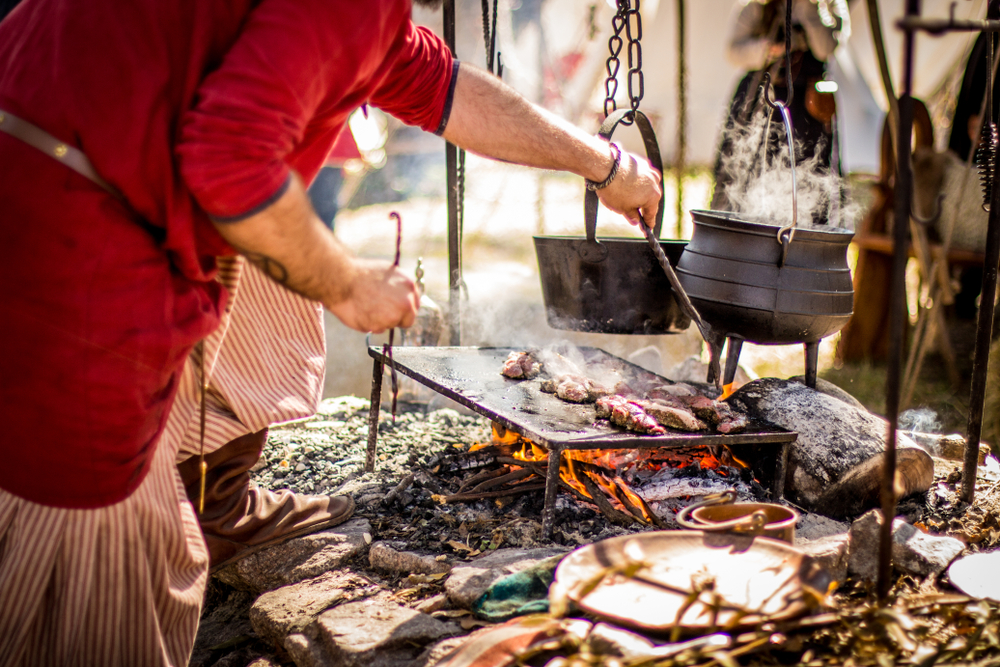
The Curious Dining of Medieval England
What we eat has obviously changed considerably over time. Today, we’re pretty spoiled. We can prepare almost any food from any cuisine in the world at home. But what would likely have been on the table during the medieval period? We can learn a little about it, thanks to The Curious Cookbook by Peter Ross, who calls himself a culinary librarian. He’s the principal librarian of the City of London’s Guildhall Library and has dug through the institution’s culinary archives.
Forget Hollywood’s representation of medieval feasts in those costume dramas. In England, the households of the nobility ate well, but you were not going to be chomping on a turkey drumstick. To impress the guests, the sophisticated chefs in the kitchens of the upper crust prepared meals that typically included high-status foods: porpoise (usually served with a wheat porridge); roasted peacock served in his feathered skin; and swan pie.
Feeding – and entertaining – the guests
Some meals were meant to showcase the prowess of the chef whose skill controlled the fires of a spit or a chafing dish or charcoal burners to create spectacular presentations. Sometimes the theme was a mythological beast, with “solteties” (subtleties) to resemble the creature – such as a cockatrice, with the body of a dragon and a rooster’s head. The cockatrice was made by scalding a capon and a small pig, cutting them in half, then sewing the top of the capon to the bottom or the pig, stuffing, and roasting the whole thing on a spit. The beast was gilded with egg yolks, powdered ginger, and saffron, then covered with parsley sauce and served. Another “entertaining” meal featured pies containing live frogs and birds. They weren’t meant to be eaten, just to dazzle the guests.
By the 1650s, French chefs began to influence their counterparts in England. Wealthy households and dinner guests were served such dishes as sautéed tortoise with asparagus; sea ducks with a sauce of chocolate, truffles, and morels; badger ham; or kebabs of ox palate, chicken-peepers, cockscombs, and oysters.
Cookbooks of the time also included recipes for dishes meant to cure illnesses of the day. That could be viper broth or snail broth, among others. And when the British began exploring and populating the new world, they adopted recipes from distant lands. In Australia, they ate kangaroo tail soup and curry, roast wallaby, and parakeet pie.
Feeding everyone else
By the 1800s, a rising tide of upper-middle-class kitchens were buying the cookbooks meant for them, and, as Jane Austen fans may know, the young women of the household were encouraged to take soups to the poor. An 1861 cookbook offered Mrs. Beeton’s Nourishing Soup for the Deserving Poor, which featured a broth made with cheap beef trimmings, bones, onions and leeks, celery, carrots, turnips, rice, or barley with 10 gallons of water and salt and pepper. It was a time when the poor folks had a meager protein intake. They got that protein from eating birds, calves’ feet, or boiled minnows.
Some of these ideas were copied when rationing struck England during the second World War. That’s when people harvested the freshly roasted seeds of asparagus and ground them to make “coffee,” a recipe invented by an aide to Napoleon. And, for protein and at the encouragement of the government, the Brits sometimes ate vine-leaf-wrapped sparrows or starlings on toast.
As for foods of the past, I’ll stay away from time machines and anyone who wants to try to tempt me with one of these concoctions. Not even if they offered a Victorian savory cheese ice cream for dessert.




